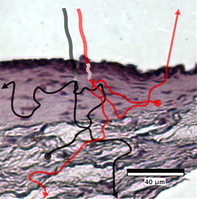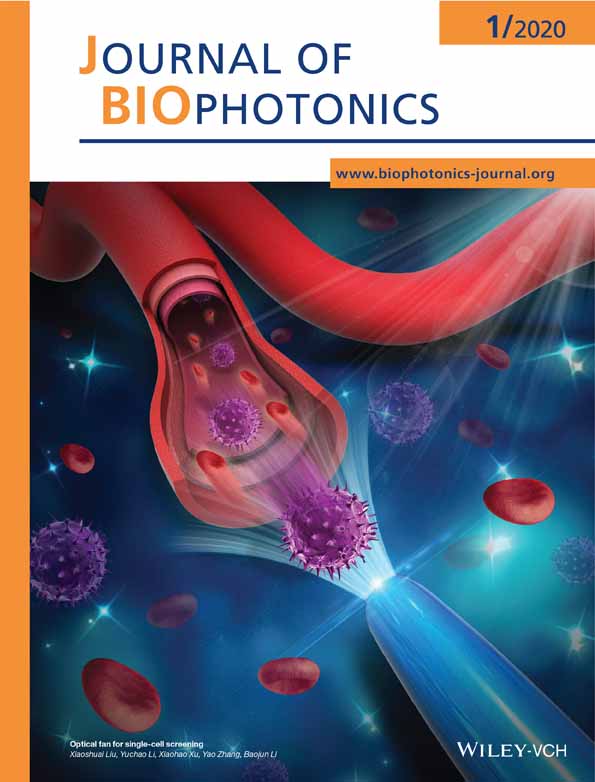Optical investigation of three-dimensional human skin equivalents: A pilot study
Corresponding Author
Akhil Kallepalli
Sensors Group, Centre for Electronic Warfare, Information and Cyber, Defence Academy of the United Kingdom, Cranfield University, Shrivenham Campus, Shrivenham, UK
Correspondence
Akhil Kallepalli, Sensors Group, Centre for Electronic Warfare, Information and Cyber, Defence Academy of the United Kingdom, Cranfield University, Shrivenham Campus, Shrivenham SN6 8LA, UK.
Email: [email protected]
Search for more papers by this authorBlake McCall
Aston Institute of Materials Research, Engineering and Applied Sciences, Aston University, Birmingham, UK
Search for more papers by this authorDavid B. James
Sensors Group, Centre for Electronic Warfare, Information and Cyber, Defence Academy of the United Kingdom, Cranfield University, Shrivenham Campus, Shrivenham, UK
Search for more papers by this authorSarah Junaid
Aston Institute of Materials Research, Engineering and Applied Sciences, Aston University, Birmingham, UK
Search for more papers by this authorJames Halls
Department of Radiology, The Great Western Hospital, Swindon, UK
Search for more papers by this authorMark A. Richardson
Sensors Group, Centre for Electronic Warfare, Information and Cyber, Defence Academy of the United Kingdom, Cranfield University, Shrivenham Campus, Shrivenham, UK
Search for more papers by this authorCorresponding Author
Akhil Kallepalli
Sensors Group, Centre for Electronic Warfare, Information and Cyber, Defence Academy of the United Kingdom, Cranfield University, Shrivenham Campus, Shrivenham, UK
Correspondence
Akhil Kallepalli, Sensors Group, Centre for Electronic Warfare, Information and Cyber, Defence Academy of the United Kingdom, Cranfield University, Shrivenham Campus, Shrivenham SN6 8LA, UK.
Email: [email protected]
Search for more papers by this authorBlake McCall
Aston Institute of Materials Research, Engineering and Applied Sciences, Aston University, Birmingham, UK
Search for more papers by this authorDavid B. James
Sensors Group, Centre for Electronic Warfare, Information and Cyber, Defence Academy of the United Kingdom, Cranfield University, Shrivenham Campus, Shrivenham, UK
Search for more papers by this authorSarah Junaid
Aston Institute of Materials Research, Engineering and Applied Sciences, Aston University, Birmingham, UK
Search for more papers by this authorJames Halls
Department of Radiology, The Great Western Hospital, Swindon, UK
Search for more papers by this authorMark A. Richardson
Sensors Group, Centre for Electronic Warfare, Information and Cyber, Defence Academy of the United Kingdom, Cranfield University, Shrivenham Campus, Shrivenham, UK
Search for more papers by this authorAbstract
Human skin equivalents (HSEs) are three-dimensional living models of human skin that are prepared in vitro by seeding cells onto an appropriate scaffold. They recreate the structure and biological behaviour of real skin, allowing the investigation of processes such as keratinocyte differentiation and interactions between the dermal and epidermal layers. However, for wider applications, their optical and mechanical properties should also replicate those of real skin. We therefore conducted a pilot study to investigate the optical properties of HSEs. We compared Monte Carlo simulations of (a) real human skin and (b) two-layer optical models of HSEs with (c) experimental measurements of transmittance through HSE samples. The skin layers were described using a hybrid collection of optical attenuation coefficients. A linear relationship was observed between the simulations and experiments. For samples thinner than 0.5 mm, an exponential increase in detected power was observed due to fewer instances of absorption and scattering.

CONFLICT OF INTEREST
The authors declare no potential conflict of interests.
REFERENCES
- 1F. Andriani, A. Margulis, N. Lin, S. Griffey, J. A. Garlick, J. Invest. Dermatol. 2003, 120, 923.
- 2M. W. Carlson, A. Alt-Holland, C. Egles, J. A. Garlick, Curr. Protoc. Cell Biol. 2008, 41, 19.9.1.
10.1002/0471143030.cb1909s41 Google Scholar
- 3C. M. A. Reijnders, A. van Lier, S. Roffel, D. Kramer, R. J. Scheper, S. Gibbs, Tissue Eng. Part A 2015, 21, 2448.
- 4H. Mertsching, M. Weimer, S. Kersen, H. Brunner, GMS Krankenhaushygiene interdisziplinär 2008, 3, 1.
10.1055/s-2007-995519 Google Scholar
- 5S. A. Prahl, M. Keijzer, S. L. Jacques, A. J. Welch, Dosimetry of Laser Radiation in Medicine and Biology, Vol. 5, SPIE, Bellingham 1989, p. 102.
- 6V. V. Tuchin, S. R. Utz, I. V. Yaroslavsky, Opt. Eng. 1994, 33, 3178.
- 7G. M. Palmer, C. Zhu, T. M. Breslin, F. Xu, K. W. Gilchrist, N. Ramanujam, Appl. Optics 2006, 45, 1072.
- 8A. Hasan, Tissue Engineering for Artificial Organs, Wiley-VCH Verlag GmbH & Co. KGaA, Weinheim 2017.
10.1002/9783527689934.ch19 Google Scholar
- 9Z. Zhang, B. B. Michniak-Kohn, Pharmaceutics 2012, 4, 26.
- 10E. R. Shamir, A. J. Ewald, Nat. Rev. Mol. Cell Biol. 2014, 15, 647.
- 11V. V. Tuchin, Physics-Uspekhi 1997, 40, 495.
10.1070/PU1997v040n05ABEH000236 Google Scholar
- 12G. V. G. Baranoski, A. Krishnaswamy, Rev. Informática Teórica 2004, 11, 33.
- 13S. L. Jacques, Phys. Med. Biol. 2013, 58, R37.
- 14 T. Vo-Dinh Ed., Biomedical Photonics Handbook, CRC Press, Boca Raton, FL 2002.
- 15V. V. Tuchin, Tissue Optics: Light Scattering Methods and Instruments for Medical Diagnosis, 2nd ed., SPIE (The Society of Photo-Optical Instrumentation Engineers), Bellingham 2007.
10.1117/3.684093 Google Scholar
- 16C. Boudoux, Fundamentals of Biomedical Optics, Blurb Incorporated, San Francisco 2016.
- 17J. A. McGrath, R. A. J. Eady, F. M. Pope, in Anatomy and Organization of Human Skin (Eds: T. Burns, S. Breathnach, N. Cox, C. Griffiths), Blackwell Science Ltd, Oxford 2004, p. 3.1.
- 18C. Allombert-Blaise, S. Tamiji, L. Mortier, H. Fauvel, M. Tual, E. Delaporte, F. Piette, E. M. DeLassale, P. Formstecher, P. Marchetti, R. Polakowska, Cell Death Differ. 2003, 10(7), 850.
- 19P. A. J. Kolarsick, M. A. Kolarsick, C. Goodwin, J. Dermatol. Nurses Assoc. 2011, 3, 203.
10.1097/JDN.0b013e3182274a98 Google Scholar
- 20W. Paul, C. Sharma, Advances in Wound Healing Materials: Science and Skin Engineering, Smithers Rapra, Akron 2015, p. 25.
- 21M. R. Wiles, J. Williams, K. A. Ahmad, Essential of Dermatology for Chiropractors, Jones and Bartlett Publishers, Burlington 2010, p. 29.
- 22J. Bensouilah, P. Buck, Aromadermatology: Aromatherapy in the Treatment and Care of Common Skin Conditions, Radcliffe, Oxford 2006, p. 1.
- 23T. M. Kolodka, J. A. Garlick, L. B. Taichman, Proc. Natl. Acad. Sci. U. S. A. 1998, 95, 4356.
- 24M. A. E. Abdallah, G. Pawar, S. Harrad, Environ. Int. 2015, 84, 64.
- 25B. Godin, E. Touitou, Adv. Drug Deliv. Rev. 2007, 59, 1152.
- 26M. Jannasch, F. Groeber, N. W. Brattig, C. Unger, H. Walles, J. Hansmann, Exp. Parasitol. 2015, 150, 22.
- 27A. De Breij, E. M. Haisma, M. Rietveld, A. El Ghalbzouri, P. J. Van Den Broek, L. Dijkshoorn, P. H. Nibbering, Antimicrob. Agents Chemother. 2012, 56, 2459.
- 28G. Sriram, M. M. Dykas, S. Ramasamy, K. Poddar, V. Krishnan-Kutty, A. Patra, T. Venkatesan, M. Bigliardi-Qi, P. L. Bigliardi, Mater. Today 2016, 19, 178.
10.1016/j.mattod.2016.01.015 Google Scholar
- 29R. R. Anderson, J. A. Parrish, J. Invest. Dermatol. 1981, 77, 13.
- 30N. M. Maughan, J. W. Moody, D. R. Miller, J. Biomed. Opt. 2013, 18, 105007 1–6.
- 31A. Jubran, Intensive Care Med. 2004, 30, 2017.
- 32S. Chandrasekhar, Radiative Transfer, Dover Publications, Inc, New York, NY 1960.
- 33M. Wolf, K. von Siebenthal, M. Keel, V. Dietz, O. Baenziger, H. U. Bucher, Physiol. Meas. 2000, 21, 481.
- 34J. M. Steinke, A. P. Shepherd, J. Opt. Soc. Am. A 1988, 5, 813.
- 35L. V. Wang, H. Wu, Biomedical Optics: Principles and Imaging, John Wiley & Sons, Inc, Hoboken 2007, p. 83.
- 36V. Venugopalan, J. S. You, B. J. Tromberg, Phys. Rev. E 1998, 58, 2395.
- 37C. Sandoval, A. D. Kim, J. Opt. Soc. Am. A 2014, 31, 628.
10.1364/JOSAA.31.000628 Google Scholar
- 38M. Doi, S. Tominaga, in Proceedings of SPIE 5008, Color Imaging VIII: Processing, Hardcopy, and Applications (Eds: R. Eschbach, G. G. Marcu), SPIE, Bellingham 2003, p. 221.
- 39S. A. Prahl, M. J. C. van Gemert, A. J. Welch, Appl. Optics 1993, 32(4), 559.
- 40T. Binzoni, T. S. Leung, A. H. Gandjbakhche, D. Rüfenacht, D. T. Delpy, Phys. Med. Biol. 2006, 51, L39.
- 41L. Wang, S. L. Jacques, L. Zheng, Comput. Methods Programs Biomed. 1995, 47, 131.
- 42D. Yudovsky, L. Pilon, Appl. Optics 2009, 48, 6670.
- 43I. V. Meglinskii, Quantum Electron. 2001, 31, 1101.
- 44T. Maeda, N. Arakawa, M. Takahashi, Y. Aizu, Opt. Rev. 2010, 17, 223.
- 45H. Nilsson, G. E. Nilsson, in Proceedings in SPIE 3252, Optical Diagnostics of Biological Fluids III (Eds: A. V. Priezzhev, T. Asakura, J. D. Briers), SPIE, Bellingham 1998, p. 44.
- 46S. V. Patwardhan, A. P. Dhawan, P. A. Relue, IEEE Trans. Biomed. Eng. 2005, 52(7), 1227.
- 47S. Kumari, A. K. Nirala, Optik Int. J. Light Electron Optics 2011, 122, 807.
10.1016/j.ijleo.2010.06.006 Google Scholar
- 48S. Chen, J. Yi, W. Liu, V. Backman, H. F. Zhang, IEEE Trans. Biomed. Eng. 2015, 62, 2308.
- 49C. Zhu, Q. Liu, J. Biomed. Opt. Lett. 2012, 17, 010501.
- 50E. Alerstam, W. C. Y. Lo, T. D. Han, J. Rose, S. Andersson-Engels, L. Lilge, Biomed. Opt. Express 2010, 1(2), 658.
- 51F. Cai, S. He, J. Biomed. Opt. 2012, 17, 1.
- 52C. Zhu, Q. Liu, J. Biomed. Opt. 2013, 18, 50902 1–13.
- 53TracePro User's Manual (Release 7.8). https://www.lambdares.com/
- 54L. G. Henyey, J. L. Greenstein, Astrophys. J. 1941, 93, 70.
- 55I. J. Bigio, S. Fantini, Quantitative Biomedical Optics (Theory, Methods, and Applications), 1st ed., Cambridge University Press, Cambridge, UK 2016, p. 19.
- 56M. J. C. van Gemert, S. L. Jacques, H. J. C. M. Sterenborg, W. M. Star, IEEE Trans. Biomed. Eng. 1989, 36, 1146.
- 57L. Lin, Y. Chen, G. Li, J. Gao, K. Wu, in Proceedings of SPIE 5630, Optics in Health Care and Biomedical Optics: Diagnostics and Treatment II (Eds: B. Chance, M. Chen, A. E. T. Chiou, Q. Luo), SPIE, Bellingham 2005, p. 486.
- 58D. Peng, H. Li, S. Xie, in Proceedings of SPIE 6534, Fifth International Conference on Photonics and Imaging in Biology and Medicine (Eds: Q. Luo, L. V. Wang, V. V. Tuchin, M. Gu), SPIE, Bellingham 2007, p. 1.
- 59D. Yudovsky, A. Nouvong, K. Schomacker, L. Pilon, in Proceedings in SPIE 7555, Advanced Biomedical and Clinical Diagnostic Systems VIII (Eds: T. Vo-Dinh, W. S. Grundfest, A. Mahadevan-Jansen), SPIE, Bellingham 2010, p. 755514.
- 60M. Sharma, R. Hennessy, M. K. Markey, J. W. Tunnell, Biomed. Opt. Express 2014, 5, 40.
- 61E. Salomatina, B. Jiang, J. Novak, A. N. Yaroslavsky, J. Biomed. Opt. 2006, 11, 064026 1–9.
- 62Y. Wang, K. L. Marshall, Y. Baba, G. J. Gerling, E. A. Lumpkin, PLoS One 2013, 8(6), e67439 1–9.
10.1371/annotation/d86a2c61-0953-4555-95bc-1ae9b8e3452c Google Scholar
- 63Y. Wang, K. L. Marshall, Y. Baba, E. A. Lumpkin, G. J. Gerling, PLoS One 2015, 10, 1.
- 64K. Chopra, D. Calva, M. Sosin, K. K. Tadisina, A. Banda, C. De La Cruz, M. R. Chaudhry, T. Legesse, C. B. Drachenberg, P. N. Manson, M. R. Christy, Aesthet. Surg. J. 2015, 35, 1007.
- 65C. Mignon, D. J. Tobin, M. Zeitouny, N. E. Uzunbajakava, Biomed. Opt. Express 2018, 9, 852.
- 66L. O. Svaasand, L. T. Norvang, E. J. Fiskerstrand, E. K. S. Stopps, M. W. Berns, J. S. Nelson, Lasers Med. Sci. 1995, 10, 55.
- 67I. V. Meglinski, S. J. Matcher, Physiol. Meas. 2002, 23, 741.
- 68G. Altshuler, M. Smirnov, I. V. Yaroslavsky, J. Phys. D Appl. Phys. 2005, 38, 2732.
- 69S. Wan, R. R. Anderson, J. A. Parrish, Photochem. Photobiol. 1981, 34, 493.
- 70R. Marchesini, C. Clemente, E. Pignoli, M. Brambilla, J. Photochem. Photobiol. B Biol. 1992, 16, 127.
- 71R. C. Simpson, M. Kohl, M. Essenpreis, M. Cope, Phys. Med. Biol. 1998, 43, 2465.
- 72A. N. Bashkatov, E. A. Genina, V. I. Kochubey, V. V. Tuchin, J. Phys. D Appl. Phys. 2005, 38, 2543.




